Discover 20 hidden attractions, cool sights, and unusual things to do in Wuhan (China). Don't miss out on these must-see attractions: Yellow Crane Tower, Happy Valley Wuhan, and Huanan Seafood Wholesale Market. Also, be sure to include Hubei Provincial Museum in your itinerary.
Below, you can find the list of the most amazing places you should visit in Wuhan (Hubei).
Table of Contents
Yellow Crane Tower

Also known as: 黄鹤楼
Elaborate, reconstructed, 5-story tower. Yellow Crane Tower is a traditional Chinese tower located in Wuhan. The current structure was built in 1981, but the tower has existed in various forms from as early as AD 223. The current Yellow Crane Tower is 51.4 m high and covers an area of 3,219 m2. It is situated on Snake Hill, one kilometer away from the original site, on the banks of the Yangtze River in Wuchang District.[1]
Address: 1 Sheshan, Wuhan
Happy Valley Wuhan
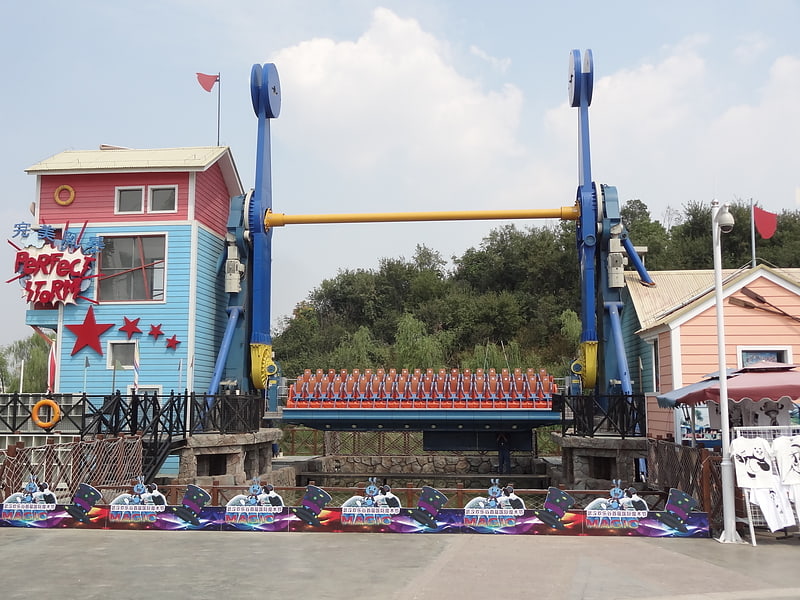
Also known as: 武汉欢乐谷
Theme park in Wuhan, China. Happy Valley Wuhan is a theme park in Hongshan District, Wuhan, Hubei Province, China. Opened on 29 April 2012, it is the fifth installation of the Happy Valley theme park chain.[2]
Address: Donghu Tourism Resort, Wuhan
Huanan Seafood Wholesale Market
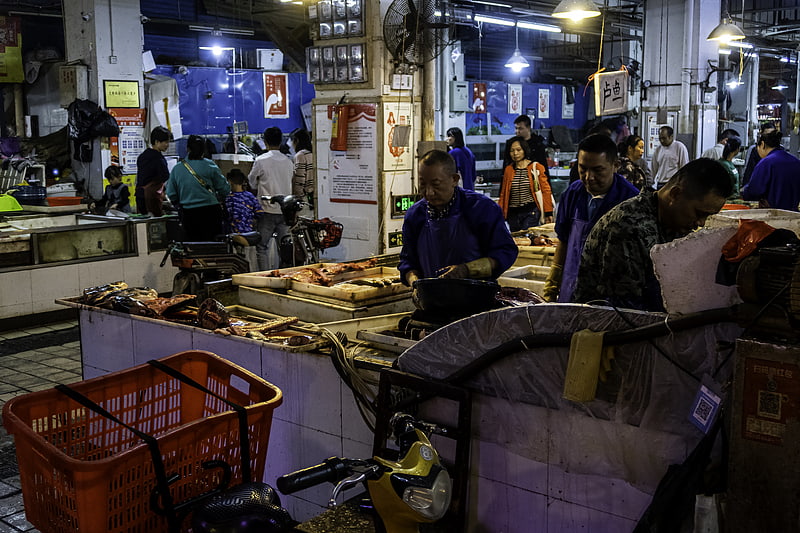
The Wuhan Huanan Seafood Wholesale Market, simply known as the Huanan Seafood Market, was a live animal and seafood market in Jianghan District, Wuhan City, the capital of Hubei Province in Central China.
The market became widely known worldwide after being identified as the 'Ground Zero' site of COVID-19 and the resulting pandemic. The World Health Organization was notified on 31 December 2019 about an outbreak of pneumonia in Wuhan. Of the initial 41 people hospitalized with pneumonia who were officially identified as having laboratory-confirmed SARS-CoV-2 infection by 2 January 2020, two-thirds were exposed to the market. The market was opened on 19 June 2002 and closed permanently on 1 January 2020 for sanitary procedures and disinfection. Thirty-three out of 585 environmental samples obtained from the market indicated evidence of coronavirus disease (COVID-19) outbreak, according to the Chinese Center for Disease Control and Prevention.[3]
Hubei Provincial Museum
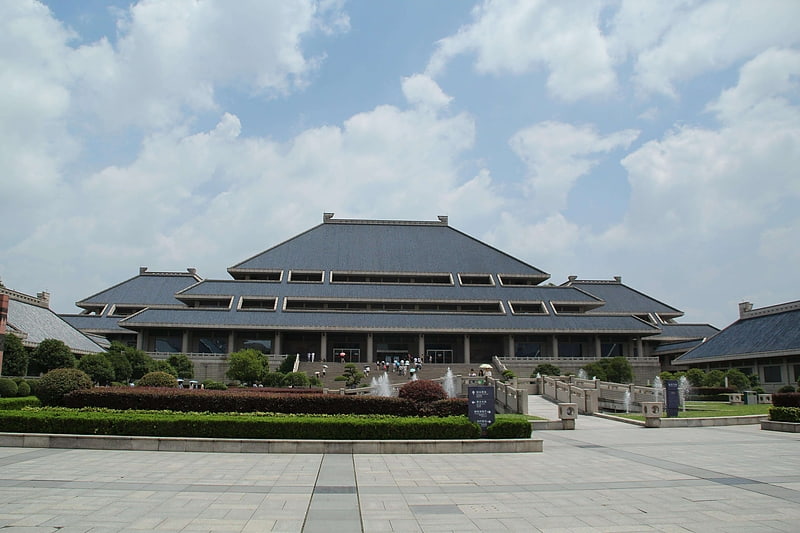
Also known as: 湖北省博物馆
Museum. The Hubei Provincial Museum is one of the best known museums in China, with a large amount of state-level historic and cultural relics. Established in 1953, the museum moved to its present location in 1960 and gained its present name in 1963. Since 1999 a number of new buildings have been added. The museum received 1,992,512 visitors in 2017.
The museum is located in the Wuchang District of Wuhan, Hubei Province, not far from the west shore of Wuhan's East Lake. It has a collection of over 200,000 objects, including the Sword of Goujian, an ancient set of bronze bells (Bianzhong) and extensive artifacts from the Tomb of Marquis Yi of Zeng and the tombs at Baoshan. The particular importance of several of the archaeological items in the museum's collection has been recognized by the national government by including them into the short list of Chinese cultural relics forbidden to be exhibited abroad.
On the afternoon of April 27, 2018, China's paramount leader Xi Jinping and Indian Prime Minister Narendra Modi visited Hubei Provincial Museum.[4]
Guiyuan Temple
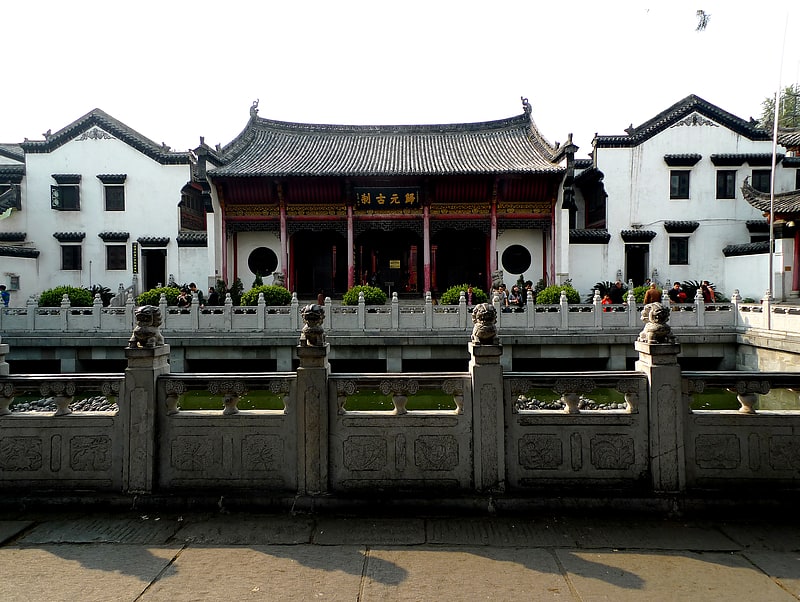
Also known as: 归元寺
Temple in Wuhan, China. Guiyuan Temple is a Buddhist temple located on Cuiwei Road in Hanyang District of Wuhan, Hubei, China.
It was built in the 15th year of Shunzhi period (1658) of the Qing dynasty (1644–1911), and has a land area of 4.67 acres (1.89 ha). The New Pavilion built in 1922 is the treasury of the temple.[5]
Wuhan Museum

Also known as: 武汉博物馆
Museum in Wuhan, China. Wuhan Museum is a museum in Wuhan, Hubei, China. Construction began in 1984 and it was opened in 1986. In 2001, a new building was completed and opened to the public. It has a total built-up area of 17,834 square metres. The display area is up to 6,000 square metres. The museum was named a national first-grade museum of China in May 2008. In January 2009, Wuhan municipal cultural relic store was merged into Wuhan Museum.[6]
Address: No.373 Qingnian Road, Hankou, 430060 Wuhan
Qingchuan Bridge
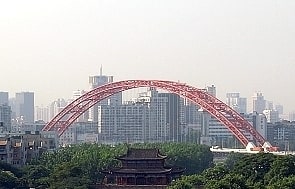
Also known as: 晴川桥
Arch bridge in Wuhan, China. The Qingchuan Bridge is an arch bridge located in Wuhan, People's Republic of China. It is the fourth bridge on the Han River, the third motorway bridge and also the "Rainbow Bridge" due to its shape and red color. The bridge has a span of 280 m, with a full length of 989.75 m. The construction of this bridge begins on Dec 20, 1997, and completed in 2000, which started revenue service to the public. It has four lanes, connects Yanhe Ave in Hankou with Hannan Rd in Hanyang. It used to be a tolled bridge, but after the implementation of electronic toll collection in Wuhan, the toll plaza was razed.[7]
Second Wuhan Yangtze River Bridge
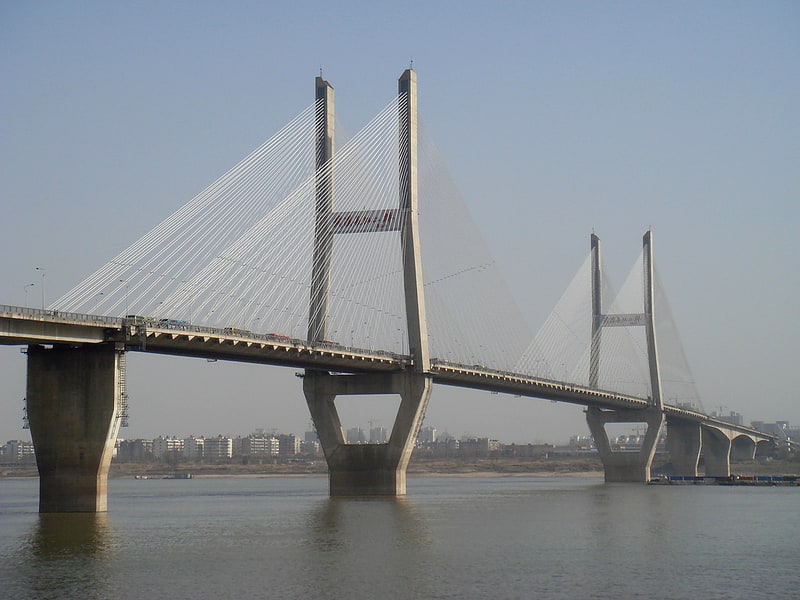
Also known as: 武汉长江二桥
Cable-stayed bridge in Wuhan, China. The Second Wuhan Yangtze River Bridge is a bridge across the Yangtze River in Wuhan, Hubei province, China. It is located northeast of the historic central area of the city's Hankou District and is the northern crossing for the Inner Ring Road. It is a cable-stayed bridge built of pre-stressed concrete, has a central span of 400 metres. It is 4.678 kilometres in length and is 26 metres wide. Its main bridgeheads are 90 metres high each, pulling 392 thick slanting cables together in the shape of double fans, so that the central span of the bridge is well-balanced on the piers and the bridge's stability and vibration resistance are ensured.[8]
Wuhan Poly Plaza
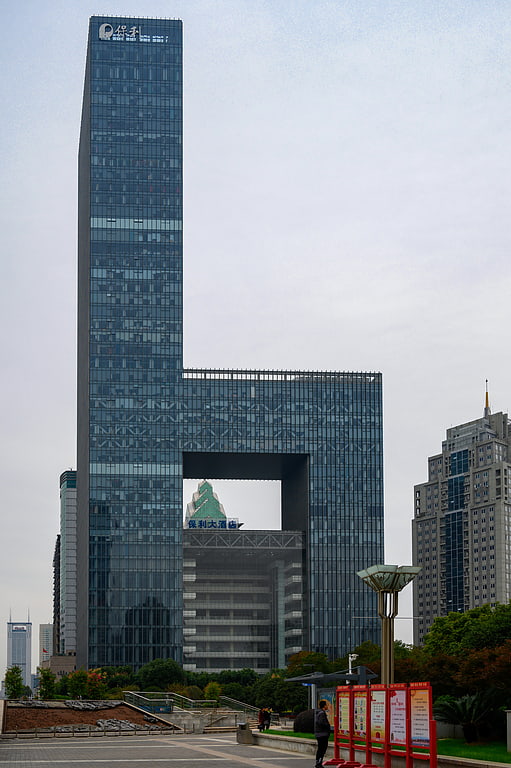
Building in Wuhan, China. Wuhan Poly Plaza, previously named Wuhan Poly Culture Plaza, is west of the intersection of Zhongnan Road and Hongshan Square in the Wuchang District of Wuhan, China. Its height is 221 meters, measured from surface to its roof; it has no spires. Designed by Skidmore, Owings & Merrill, it has a floor area of 149,000 m2, which includes both the 46 floors of the main tower and 20 floors of its annex. With a design similar to a chair, the building leaves an open space between the main tower and its annex, below the bridge connecting those two at the height of its 20th floor. Floor 1 to 5 is designed as a shopping mall, 6 and 7 as restaurant and food court, 8 for a movie theater, and the rest of the floors for office space.[9]
Institute of Hydrobiology
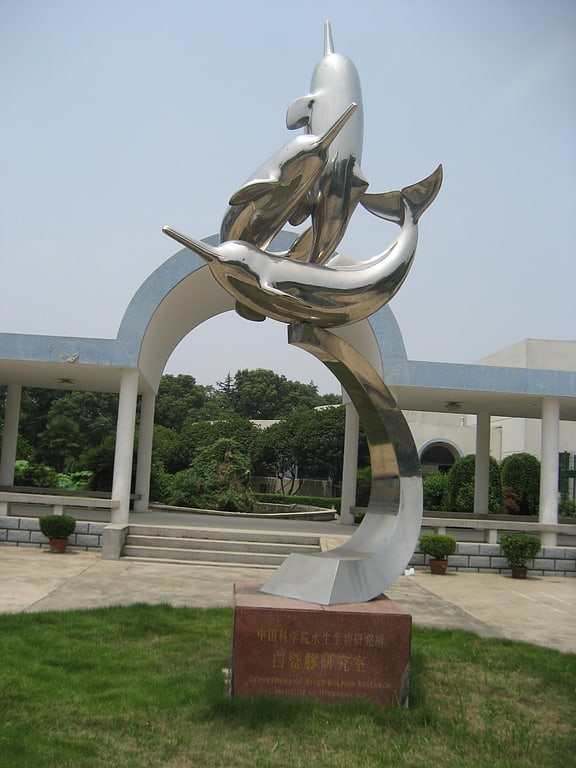
Institute of Hydrobiology of the Chinese Academy of Sciences is a research institute located in Wuhan, Hubei, China. It was founded in 1950 and specializes in freshwater organisms. It is involved in the study of the finless porpoise and the now extinct baiji dolphin. China Zebrafish Resource Center is housed in the institute campus.[10]
Hanyang

Hanyang District forms part of the urban core of and is one of 13 urban districts of the prefecture-level city of Wuhan, the capital of Hubei Province, China. Currently, it is a district and stands between the Han River and the Yangtze River, where the former drains into the latter. It is connected by bridges with its former sister cities, Hankou and Wuchang. Presently, on the left bank of the Yangtze, it borders the districts of Qiaokou to the north across the Han River, Jianghan to the northeast, Caidian to the southwest, and Dongxihu to the northwest; on the opposite bank it borders Wuchang and Hongshan. Guiyuan Temple is located in Hanyang.
The name "Hanyang" means "the Yang side of Han River", referring to the town's historic location on the north ("yang") bank of the Han River mouth. However, the lower Han River changed course to the north side of the town during Ming dynasty's Chenghua-era. The town, now on the south ("yin") side of the river, should have been renamed to "Hanyin" by naming convention, but the name "Hanyang" remained as it was well-established since the Sui dynasty. Administratively, the area forms Hanyang District of the modern Wuhan city, with an area of 108 square kilometers (42 sq mi) and a population of 510,000.
The Hanyang Arsenal is known for its production of the so-called "Hanyang rifle" - an indigenous Asian copy of the German Model 1888 Commission Rifle, which was heavily used in World War II, as well as in the Korean War and Vietnam War.[11]
Wuhan Yangtze River Bridge
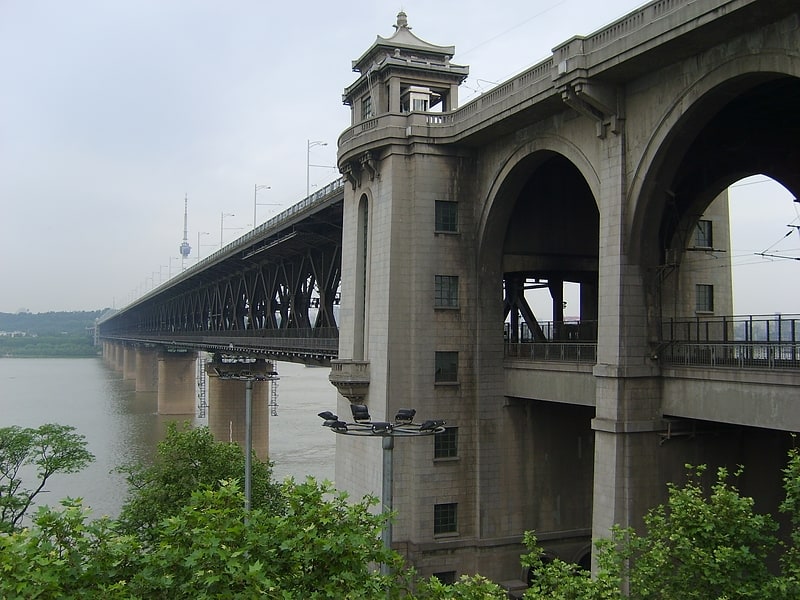
Also known as: 武汉长江大桥
Truss bridge in Wuhan, China. The Wuhan Yangtze Great Bridge, commonly known as Wuhan First Yangtze Bridge, is a double-deck road and rail bridge across the Yangtze River in Wuhan, in Central China. At its completion in 1957, the bridge was the easternmost crossing of the Yangtze, and was often referred to as the "First Bridge of the Yangtze".
The bridge extends 1.6 kilometers (1 mile) from Turtle Hill in Hanyang, on the northern bank of the Yangtze, to Snake Hill in Wuchang, on the southern bank of the Yangtze. Plans for the bridge's construction were first made in 1910. A total of four exploratory surveys were made between 1913 and 1948 to identify a suitable site, but economic limitations and the combination of World War II and the Chinese Civil War prevented the bridge's building until the 1950s. Actual construction began in September 1955 and was completed in October 1957.
The upper level of the bridge is a two-way, four-lane automobile highway. The lower level is a double-track railway on the Beijing-Guangzhou railway line.[12]
Tortoise Mountain TV Tower

Tower in Wuhan, China. Tortoise Mountain TV Tower is a 311.4 metres high TV Tower in Hanyang District, Wuhan, Hubei, China. It is a concrete tower equipped with an observation deck in a height of 221.2 metres. It does not stand directly upon the hill, which is occupied by an ancient temple complex. Guishan TV Tower is China's first self-developed TV tower, opened in 1986.
The tower is located on Guishan ("Tortoise Mountain" or "Turtle Mountain") on the left (northwestern) bank of the Yangtze river, in the part of Wuhan that was historically known as Hanyang. It is located upon the northwestern shoulder of the mountain, reducing the impact upon the ancient temple set upon the peak, that peak being one of the two famous hills of Wuhan, the other being Sheshan (the Snake Mountain) on the opposite, right bank of the Yangtze, in Wuchang; the ancient Yellow Crane Tower is located there. Both hills have many historic ruins, and rows of sculptures of ancient warriors line the hill.[13]
East Lake

Also known as: 东湖
Lake in China. East Lake is a large freshwater lake within the city limits of Wuhan, China, the largest or the second largest urban lake in China. Wuhan's East Lake covers an area of 88 square kilometers. It is one of the 5A tourist zones of China, and admits over a million people yearly. It is one of the largest sites in Huazhong District. It is also the largest "City Lake" in China. East Lake is made of four areas, Ting Tao, Moshan, Luo Yan Island and Museum of Hubei Province.
One end of Moshan features a Daoist temple built over the putative site of where one of the characters in Romance of the Three Kingdoms performed special Qimen Dunjia rites before the famous battle of Red Cliffs. No one knows precisely the actual location, but the Moshan site was an archeological dig in the early part of the twentieth century.[14]
Wuhan Botanical Garden
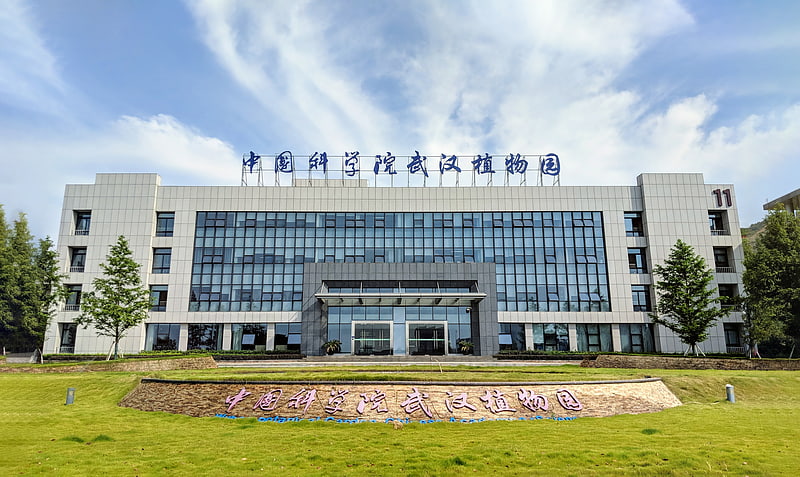
Also known as: 中国科学院武汉植物园
National park in Wuhan, China. Wuhan Botanical Garden, or WBG, located in Wuhan, Hubei, China, has a collection of more than 4000 species of flora. WBG has a regular program to educate and create awareness about plant life and biodiversity amongst the general public.
The Wuhan Botanical Garden was created in 1956. It opened to the public two years later. The garden is one of China's three research-oriented botanical gardens. The garden was established to develop and maintain plant collections for purposes of display, conservation, education and research.
Wuhan Botanical Garden has 16 specialty gardens. Its Kiwifruit Garden and the National Kiwifruit Germplasm Repository contain over 70 percent of the world's kiwifruit species. Similarly, the Aquatic Plant Garden is the largest of its kind in the world. Its Wild Fruit Garden, the Rare and Endangered Plant Garden, and the Medicinal Herb Garden are the largest in China.[15]
Jiali Plaza
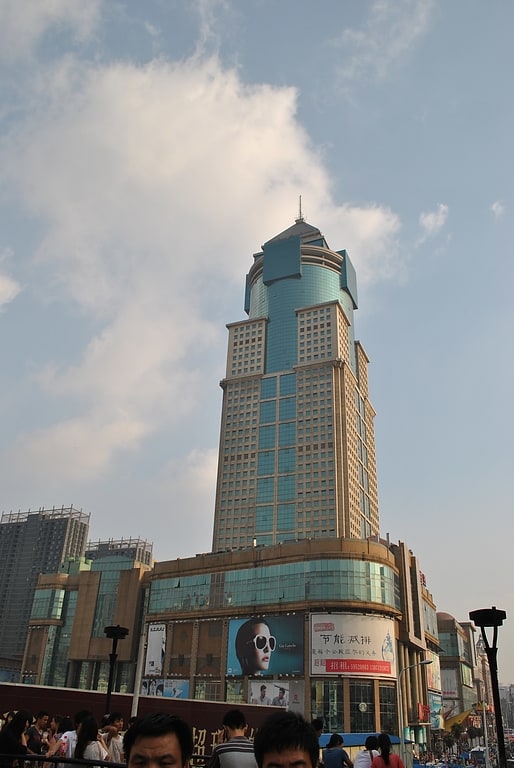
Also known as: 佳丽广场
Skyscraper in Wuhan, China. Jiali Plaza, also known as Ping An Building, is a 251-metre tall skyscraper located in Wuhan, China. The 61 storey building was completed in 1997 under the design by WMKY Lim. The building has two underground floors which are used as a car park.[16]
Tianxingzhou Yangtze River Bridge
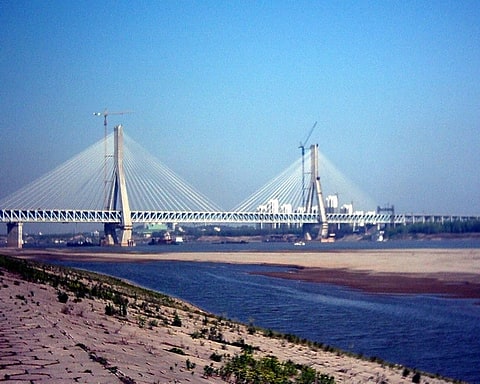
Also known as: 天兴洲长江大桥
Cable-stayed bridge in Wuhan, China. The Tianxingzhou Yangtze River Bridge is a combined road and rail bridge across the Yangtze River in the city of Wuhan, the capital of the Hubei Province of China.
The bridge crosses the Yangtze in the northeastern part of the city, a few kilometers downstream of the Second Wuhan Yangtze River Bridge. Its name is due to the Tianxing Island (天兴洲, Tianxingzhou), above which it crosses the river. Built at the cost of CN¥11 billion, the 4,657-meter cable suspension bridge was opened on December 26, 2009, in time for the opening of the Wuhan railway station. The bridges main span measures 504 metres (1,654 ft), the longest combined road and rail cable-stayed span in the world.[17]
South Lake
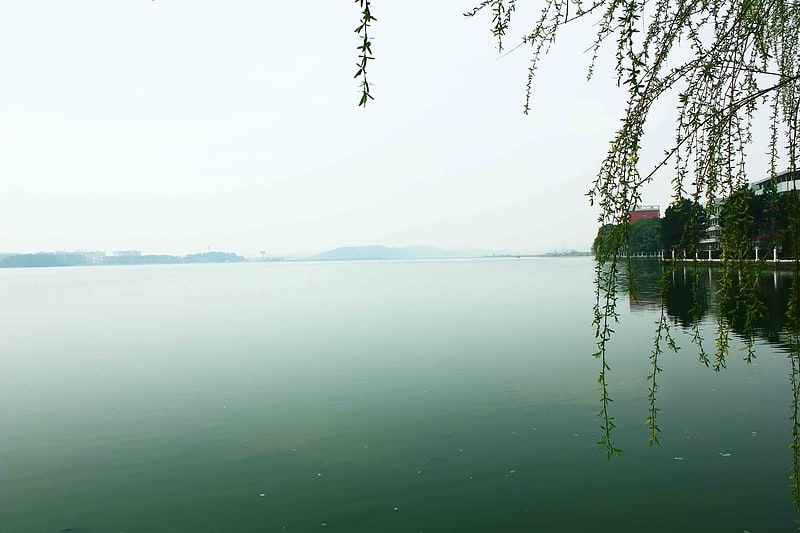
Also known as: 南湖
Lake in China. South Lake is a subtropical shallow freshwater lake located in Nanhu Subdistrict, in the southern suburbs of Wuchang, Wuhan, Hubei Province, China. It has an average depth of 1.6 metres, lake bottom elevation 18 m, the width of the lake is about 15.4 km long, the length of the lake is about 5.4 km wide, area of 5km².[18]
Wuying Pagoda
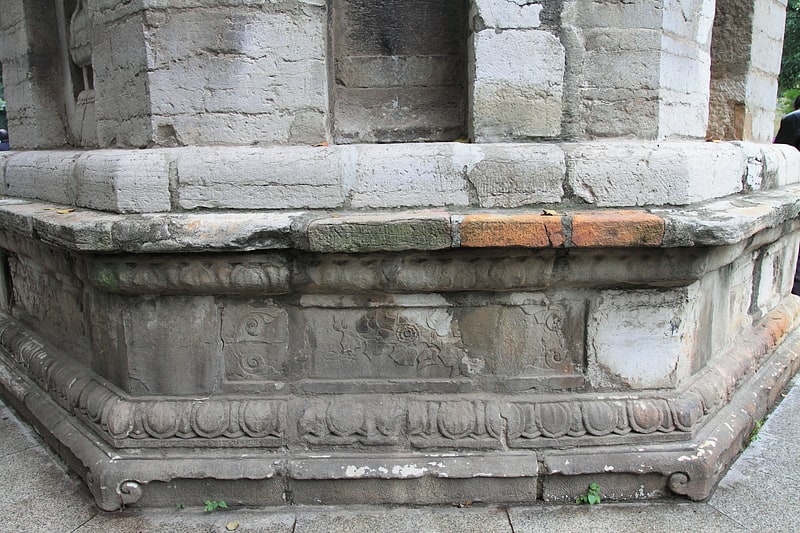
Also known as: 无影塔
Tower in Wuhan, China. The Wuying Pagoda, also known as the Xingfu Temple Pagoda and The Thousand Year-old Pagoda of Wuhan, is a Buddhist pagoda in Wuchang, Wuhan, Hubei Province, China. Built of stone 750 years ago during the final years of the Southern Song Dynasty, it is the oldest standing architectural feature in Wuhan. Wuying Pagoda is a Major Historical and Cultural Site Protected at the National Level.[19]
Hankou
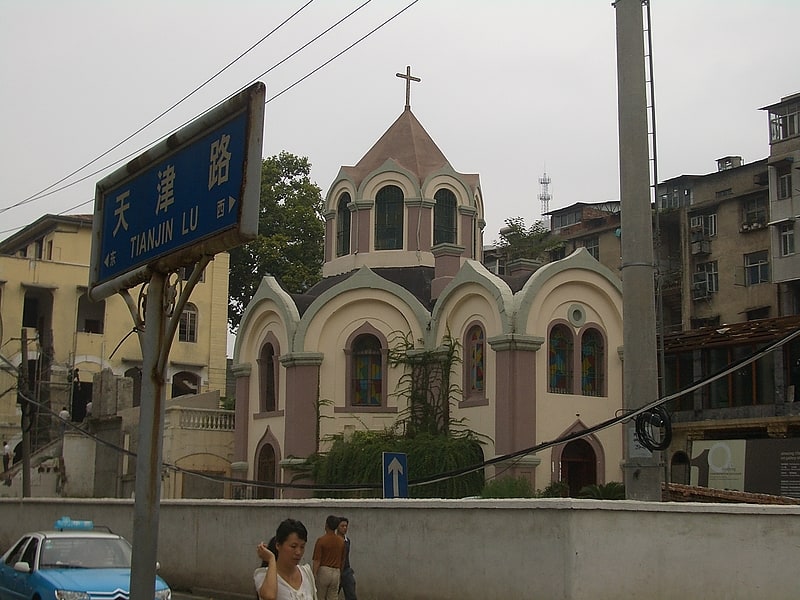
Also known as: 汉口
City in China. Hankou, alternately romanized as Hankow, was one of the three towns merged to become modern-day Wuhan city, the capital of the Hubei province, China. It stands north of the Han and Yangtze Rivers where the Han flows into the Yangtze. Hankou is connected by bridges to its triplet sister towns Hanyang and Wuchang.
Hankou is the main port of Hubei province and the single largest port in the middle reaches of Yangtze.[20]